Evaluating the Potential of MAMCA as a Framework for Stakeholder Engagement during the Setup of Energy Communities
Abstract
1. Introduction
2. Theoretical Background
2.1. MCDA/M and MAMCA
- Step 1: alternatives or scenario definition.
- Step 2: determining the stakeholders and their criteria.
- Step 3: criteria weighting.
- Step 4: linking measurable indicators to the criteria.
- Step 5: alternatives evaluation.
- Step 6: evaluation results and ranking with consensus building.
2.2. Evaluation of Engagement Initiatives
3. MAMCA Stakeholder Engagement Framework for the Setup of ECs
3.1. EC Process Phases and Accompanying Engagement Goals
- Gathering information on stakeholder needs to use as input for building potentially fitted EC designs;
- Building relevant EC designs (‘alternatives’) together with the stakeholders;
- Co-decision making on which EC design will be implemented and under what preconditions.
3.2. The MAMCA Framework for the Setup of ECs
4. Methodology for the Evaluation of the Framework
5. Evaluation of the Framework
5.1. Theoretical Evaluation Based on Existing Stakeholder Engagement Principles
5.1.1. Link with the Ladder and Wheel of Participation
5.1.2. Best Practice Principles for Stakeholder Engagement in EC Design
- “Stakeholder participation needs to be underpinned by a philosophy that emphasizes empowerment, equity, trust, and learning;
- Where relevant, stakeholder participation should be considered as early as possible and throughout the process;
- Relevant stakeholders need to be analyzed and represented systematically;
- Clear objectives for the participatory process need to be agreed among stakeholders at the outset;
- Methods should be selected and tailored to the decision-making context, considering the objectives, type of participants, and appropriate level of engagement;
- Highly skilled facilitation is essential;
- Local and scientific knowledges should be integrated;
- Participation needs to be institutionalized.”
- The framework offers the opportunity to collect and take into account the input of every stakeholder and conduct an open process. Depending on the predetermined goal, stakeholder empowerment can take on many forms and intensities. In every phase, stakeholders can be provided with all the educational material needed to understand all elements that are important for decision making and with tools that are usable and easily accessible to everyone. Throughout the process, multiple interaction opportunities are created between everyone involved, which stimulates mutual learning and understanding.
- Stakeholder engagement is foreseen from the very start and takes on varying forms throughout the different phases of the process. This leads to EC alternatives that capture the various interests at stake, as is the case in the plural planning tradition [50].
- In step 2 of the MAMCA framework, all relevant stakeholders are identified to be represented and receive an equal voice in the process. Heuninckx et al. [51] give an overview of potential stakeholder groups.
- The premise of the framework is that the process starts with defining the goal of the engagement activities to be able to define the necessary steps and tools. This has to be clearly communicated to the stakeholders involved. Figure 4 shows the potential engagement goals that are identified for an EC setup process.
- Depending on the engagement goal, the MAMCA framework offers appropriate tools that can be used, all with active stakeholder involvement at their base.
- The overall engagement process needs to be managed by an experienced and preferably external facilitator. Impartiality is essential to guarantee an open discussion in which every stakeholder gets an equal chance to be heard. In some of the specific tools that deal with the more technical and complex inherent aspects of an EC (in steps 1, 4, and 5), the assistance of an expert in the field is mentioned as a prerequisite.
- The preparation phase and steps 1 and 5 of the framework are centered around the integration of local and expert knowledge. Since EC design has a large technical component, expert input is essential in the process and provides technical modeling, legal, and social support to guide stakeholders to well-informed decision making.
- Making the MAMCA framework the backbone of an officially written down and agreed-upon engagement plan at the start of every EC setup process can help battle window-dressing forms of stakeholder participation.
5.2. Evaluation through Case Study Application
5.2.1. Case Study Specifications
5.2.2. Case Study Findings on the Framework Application
5.2.3. Case Study Findings on the Effects of the Used Framework Tools on the Engagement Goals
6. Conclusions and Suggestions for Further Research
Author Contributions
Funding
Data Availability Statement
Conflicts of Interest
Appendix A. Pre-MAMCA Workshop Survey Questions
- ○
- No
- ○
- I have the feeling I don’t know enough about the subject to answer
- ○
- Maybe
- ○
- Yes
Appendix B. Post-MAMCA Workshop Survey Questions
- ○
- No
- ○
- I have the feeling I don’t know enough about the subject to answer
- ○
- Maybe
- ○
- Yes
- ○
- Yes
- ○
- No, I already was aware and did not gain new insights through the workshop
References
- United Nations. Transforming Our World the 2030 Agenda for Sustainable Development; United Nations: New York, NY, USA, 2015. [Google Scholar]
- Siciliano, G.; Wallbott, L.; Urban, F.; Dang, A.N.; Lederer, M. Low-Carbon Energy, Sustainable Development, and Justice: Towards a Just Energy Transition for the Society and the Environment. Sustain. Dev. 2021, 29, 1049–1061. [Google Scholar] [CrossRef]
- Burke, M.J.; Stephens, J.C. Energy Democracy: Goals and Policy Instruments for Sociotechnical Transitions. Energy Res. Soc. Sci. 2017, 33, 35–48. [Google Scholar] [CrossRef]
- Van der Schoor, T.; Scholtens, B. Power to the People: Local Community Initiatives and the Transition to Sustainable Energy. Renew. Sustain. Energy Rev. 2015, 43, 666–675. [Google Scholar] [CrossRef]
- European Parliament & Council of the European Union Directive (EU). 2019/944 on Common Rules for the Internal Market for Electricity and Amending Directive 2012/27/EU. Off. J. Eur. Union 2019, 158, 125–199. [Google Scholar]
- European Parliament & Council of the European Union Directive (EU) 2018/2001 on the Promotion of the Use of Energy from Renewable Sources. Off. J. Eur. Union 2018, 328, 82–209.
- Caramizaru, A.; Uihlein, A. Energy Communities: An Overview of Energy and Social Innovation; Publications Office of the European Union: Luxembourg, 2020. [Google Scholar]
- Koirala, B.P.; Araghi, Y.; Kroesen, M.; Ghorbani, A.; Hakvoort, R.A.; Herder, P.M. Trust, Awareness, and Independence: Insights from a Socio-Psychological Factor Analysis of Citizen Knowledge and Participation in Community Energy Systems. Energy Res. Soc. Sci. 2018, 38, 33–40. [Google Scholar] [CrossRef]
- Heuninckx, S.; te Boveldt, G.; Coosemans, T. Towards a Construction Kit for Energy Communities. 2023; under review, not publicly available yet. [Google Scholar]
- Rodrigues, L.; Gillott, M.; Waldron, J.; Cameron, L.; Tubelo, R.; Shipman, R.; Ebbs, N.; Bradshaw-Smith, C. User Engagement in Community Energy Schemes: A Case Study at the Trent Basin in Nottingham, UK. Sustain. Cities Soc. 2020, 61, 102187. [Google Scholar] [CrossRef]
- Ghazal Aswad, N.; Al-Saleh, Y. IJIKMMENA 2,2 Clean Energy Awareness Campaigns in the Uae: An Awareness Promoters PerspeCtive. Int. J. Innov. Knowl. Manag. MENA 2012, 2, 131–156. [Google Scholar]
- Heaslip, E.; Fahy, F. Developing Transdisciplinary Approaches to Community Energy Transitions: An Island Case Study. Energy Res. Soc. Sci. 2018, 45, 153–163. [Google Scholar] [CrossRef]
- Mishra, R.; Naik, B.K.R.; Raut, R.D.; Paul, S.K. Circular Economy Principles in Community Energy Initiatives through Stakeholder Perspectives. Sustain Prod. Consum. 2022, 33, 256–270. [Google Scholar] [CrossRef]
- Marinakis, V.; Papadopoulou, A.G.; Doukas, H.; Psarras, J. A Web Tool for Sustainable Energy Communities. Int. J. Inf. Decis. Sci. 2015, 7, 18–31. [Google Scholar] [CrossRef]
- Kumar, A.; Sah, B.; Singh, A.R.; Deng, Y.; He, X.; Kumar, P.; Bansal, R.C. A Review of Multi Criteria Decision Making (MCDM) towards Sustainable Renewable Energy Development. Renew. Sustain. Energy Rev. 2017, 69, 596–609. [Google Scholar] [CrossRef]
- Estévez, R.A.; Walshe, T.; Burgman, M.A. Capturing Social Impacts for Decision-Making: A Multicriteria Decision Analysis Perspective. Divers. Distrib. 2013, 19, 608–616. [Google Scholar] [CrossRef]
- McKenna, R.; Bertsch, V.; Mainzer, K.; Fichtner, W. Combining Local Preferences with Multi-Criteria Decision Analysis and Linear Optimization to Develop Feasible Energy Concepts in Small Communities. Eur. J. Oper. Res. 2018, 268, 1092–1110. [Google Scholar] [CrossRef]
- Stewart, T. A Critical Survey on the Status of Multiple Criteria Decision Making Theory and Practice. Omega 1992, 20, 569–586. [Google Scholar] [CrossRef]
- Te Boveldt, G.; Keseru, I.; Macharis, C. When Monetarisation and Ranking Are Not Appropriate. A Novel Stakeholder-Based Appraisal Method. Transp Res. Part A Policy Pract. 2022, 156, 192–205. [Google Scholar] [CrossRef]
- Ignaccolo, M.; Inturri, G.; García-Melón, M.; Giuffrida, N.; Le Pira, M.; Torrisi, V. Combining Analytic Hierarchy Process (AHP) with Role-Playing Games for Stakeholder Engagement in Complex Transport Decisions. Transp. Res. Procedia 2017, 27, 500–507. [Google Scholar] [CrossRef]
- Le Pira, M.; Inturri, G.; Ignaccolo, M.; Pluchino, A. Dealing with the Complexity of Stakeholder Interaction in Participatory Transport Planning. Adv. Intell. Syst. Comput. 2018, 572, 55–72. [Google Scholar] [CrossRef]
- Gonzalez-Urango, H.; Mu, E.; García-Melón, M. Stakeholder Engagement and ANP Best Research Practices in Sustainable Territorial and Urban Strategic Planning. In Multiple Criteria Decision Making for Sustainable Development: Pursuing Economic Growth, Environmental Protection and Social Cohesion; Springer: Berlin/Heidelberg, Germany, 2021; pp. 93–130. [Google Scholar] [CrossRef]
- Kowalski, K.; Stagl, S.; Madlener, R.; Omann, I. Sustainable Energy Futures: Methodological Challenges in Combining Scenarios and Participatory Multi-Criteria Analysis. Eur. J. Oper. Res. 2009, 197, 1063–1074. [Google Scholar] [CrossRef]
- Macharis, C.; Turcksin, L.; Lebeau, K. Multi Actor Multi Criteria Analysis (MAMCA) as a Tool to Support Sustainable Decisions: State of Use. Decis. Support Syst. 2012, 54, 610–620. [Google Scholar] [CrossRef]
- Milan, L.; Kin, B.; Verlinde, S.; Macharis, C. Multi-Actor Multi-Criteria Analysis for Sustainable City Distribution: A New Assessment. Int. J. Multicriteria Decis. Mak. 2015, 5, 334–354. [Google Scholar] [CrossRef]
- Verlinde, S.; Macharis, C. Who Is in Favor of Off-Hour Deliveries to Brussels Supermarkets? Applying Multi Actor Multi Criteria Analysis (MAMCA) to Measure Stakeholder Support. Transp. Res. Procedia 2016, 12, 522–532. [Google Scholar] [CrossRef]
- Verlinde, S.; Macharis, C.; Milan, L.; Kin, B. Does a Mobile Depot Make Urban Deliveries Faster, More Sustainable and More Economically Viable: Results of a Pilot Test in Brussels. Transp. Res. Procedia 2014, 4, 361–373. [Google Scholar] [CrossRef]
- Aljohani, K.; Thompson, R.G. A Stakeholder-Based Evaluation of the Most Suitable and Sustainable Delivery Fleet for Freight Consolidation Policies in the Inner-City Area. Sustainability 2019, 11, 124. [Google Scholar] [CrossRef]
- Fredriksson, A.; Janné, M.; Nolz, P.; de Radiguès de Chennevière, P.; van Lier, T.; Macharis, C. Creating Stakeholder Awareness in Construction Logistics by Means of the MAMCA. City Environ. Interact. 2021, 11, 100067. [Google Scholar] [CrossRef]
- Almeida, A.C.L. Multi Actor Multi Criteria Analysis (MAMCA) as a Tool to Build Indicators and Localize Sustainable Development Goal 11 in Brazilian Municipalities. Heliyon 2019, 5, e02128. [Google Scholar] [CrossRef]
- Macharis, C.; Baudry, G. Decision-Making for Sustainable Transport and Mobility Multi Actor Multi Criteria Analysis; Edward Elgar: Broadheath, UK, 2018; ISBN 9781788111799. [Google Scholar]
- Freeman, R.E. Strategic Management: A Stakeholder Approach; Pitman: Boston, UK, 1984. [Google Scholar]
- Glass, J.J. Citizen Participation in Planning: The Relationship Between Objectives and Techniques. J. Am. Plan. Assoc. 1979, 45, 180–189. [Google Scholar] [CrossRef]
- Innes, J.E.; Booher, D.E. Reframing Public Participation: Strategies for the 21st Century. Plan. Theory Pract. 2004, 5, 419–436. [Google Scholar] [CrossRef]
- Rosener, J.B. A Cafeteria of Techniques and Critiques. Public Manag. 1975, 57, 16–19. [Google Scholar]
- Cundy, A.B.; Bardos, R.P.; Church, A.; Puschenreiter, M.; Friesl-Hanl, W.; Müller, I.; Neu, S.; Mench, M.; Witters, N.; Vangronsveld, J. Developing Principles of Sustainability and Stakeholder Engagement for “Gentle” Remediation Approaches: The European Context. J. Env. Manag. 2013, 129, 283–291. [Google Scholar] [CrossRef]
- Warner, M. ‘Consensus’ Participation: An Example for Protected Areas Planning. Ltd. Public. Admin. Dev. 1997, 17, 413–432. [Google Scholar] [CrossRef]
- Carson, L. Deliberative Public Participation and Hexachlorobenzene Stockpiles. J. Env. Manag. 2009, 90, 1636–1643. [Google Scholar] [CrossRef]
- Burke, E.M. Citizen Participation Strategies. J. Am. Plan. Assoc. 1968, 34, 287–294. [Google Scholar] [CrossRef]
- Pretty, J.N. Participatory Learning for Sustainable Agriculture. World Dev. 1995, 23, 1247–1263. [Google Scholar] [CrossRef]
- Lawrence, A. “No Personal Motive?” Volunteers, Biodiversity, and the False Dichotomies of Participation. Ethics Place Environ. 2006, 9, 279–298. [Google Scholar] [CrossRef]
- Arnstein, S.R. A Ladder Of Citizen Participation. J. Am. Plan. Assoc. 1969, 35, 216–224. [Google Scholar] [CrossRef]
- Hart, R.A. Children’s Participation From Tokenism to Citizenship; UNICEF: Firenze, Italy, 1992. [Google Scholar]
- Rocha, E.M. A Ladder of Empowerment. SAGE J. 2016, 17, 31–44. [Google Scholar] [CrossRef]
- Davidson, S. Spinning the Wheel of Empowerment. Planning 1998, 1262, 14–15. [Google Scholar]
- Reed, M.S. Stakeholder Participation for Environmental Management: A Literature Review. Biol. Conserv. 2008, 141, 2417–2431. [Google Scholar] [CrossRef]
- Lode, M.L.; Heuninckx, S.; te Boveldt, G.; Macharis, C.; Coosemans, T. Designing Successful Energy Communities: A Comparison of Seven Pilots in Europe Applying the Multi-Actor Multi-Criteria Analysis. Energy Res. Soc. Sci. 2022, 90, 102671. [Google Scholar] [CrossRef]
- Huang, H.; Lebeau, P.; Macharis, C. The Multi-Actor Multi-Criteria Analysis (MAMCA): New Software and New Visualizations. In Proceedings of the Lecture Notes in Business Information Processing; Springer: Berlin/Heidelberg, Germany, 2020; Volume 384, pp. 43–56. [Google Scholar]
- Saaty, R.W. The Analytic Hierarchy Process–What It Is and How It Is Used. Math. Model. 1987, 9, 161–176. [Google Scholar] [CrossRef]
- Davidoff, P. Advocacy and Pluralism in Planning. J. Am. Plan. Assoc. 1965, 31, 331–338. [Google Scholar] [CrossRef]
- Heuninckx, S.; te Boveldt, G.; Macharis, C.; Coosemans, T. Stakeholder Objectives for Joining an Energy Community: Flemish Case Studies. Energy Policy 2022, 162, 112808. [Google Scholar] [CrossRef]
- Edwards, W. How to Use Multiattribute Utility Measurement for Social Decisionmaking. IEEE Trans Syst. Man. Cybern. 1977, 7, 326–340. [Google Scholar] [CrossRef]
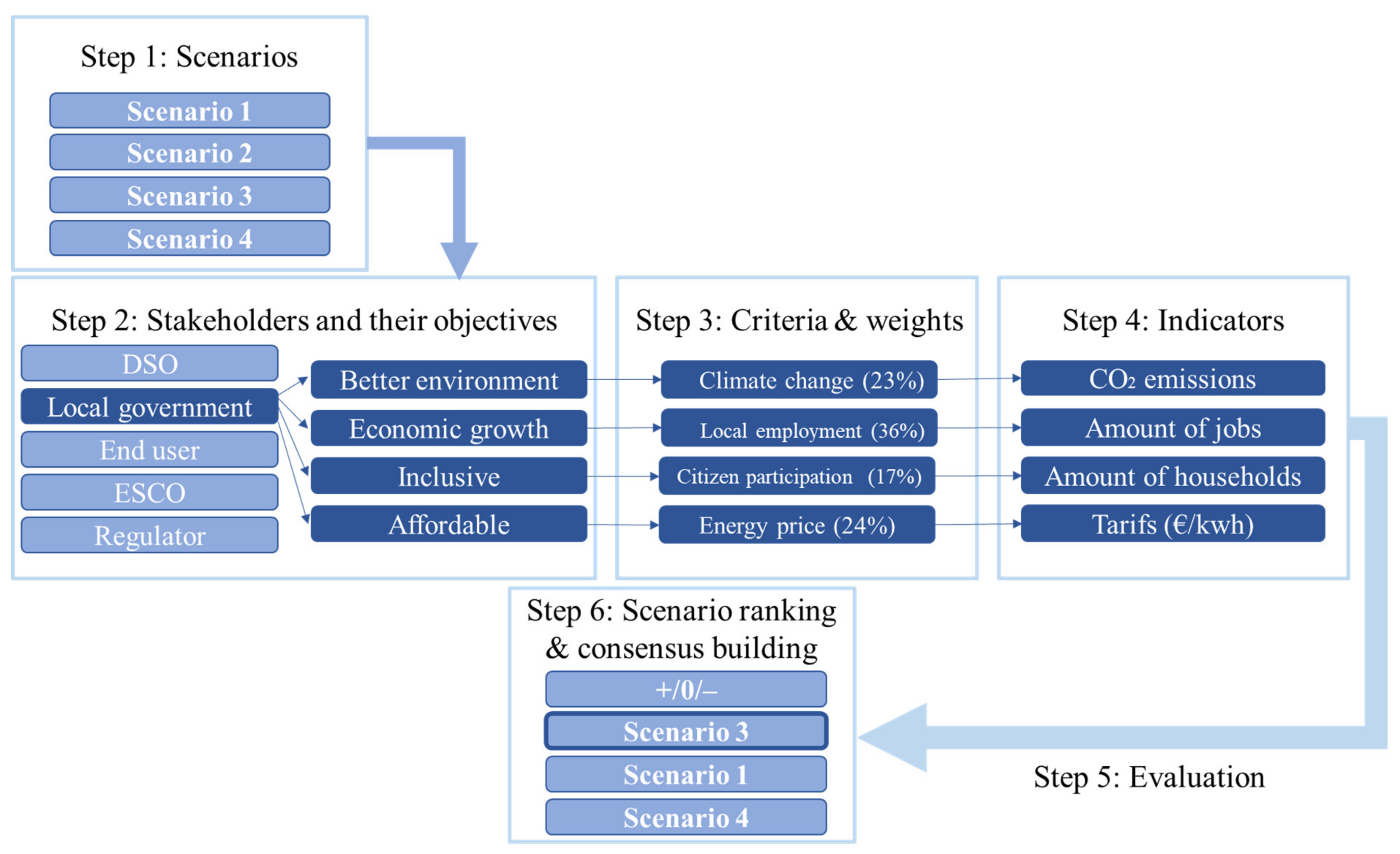
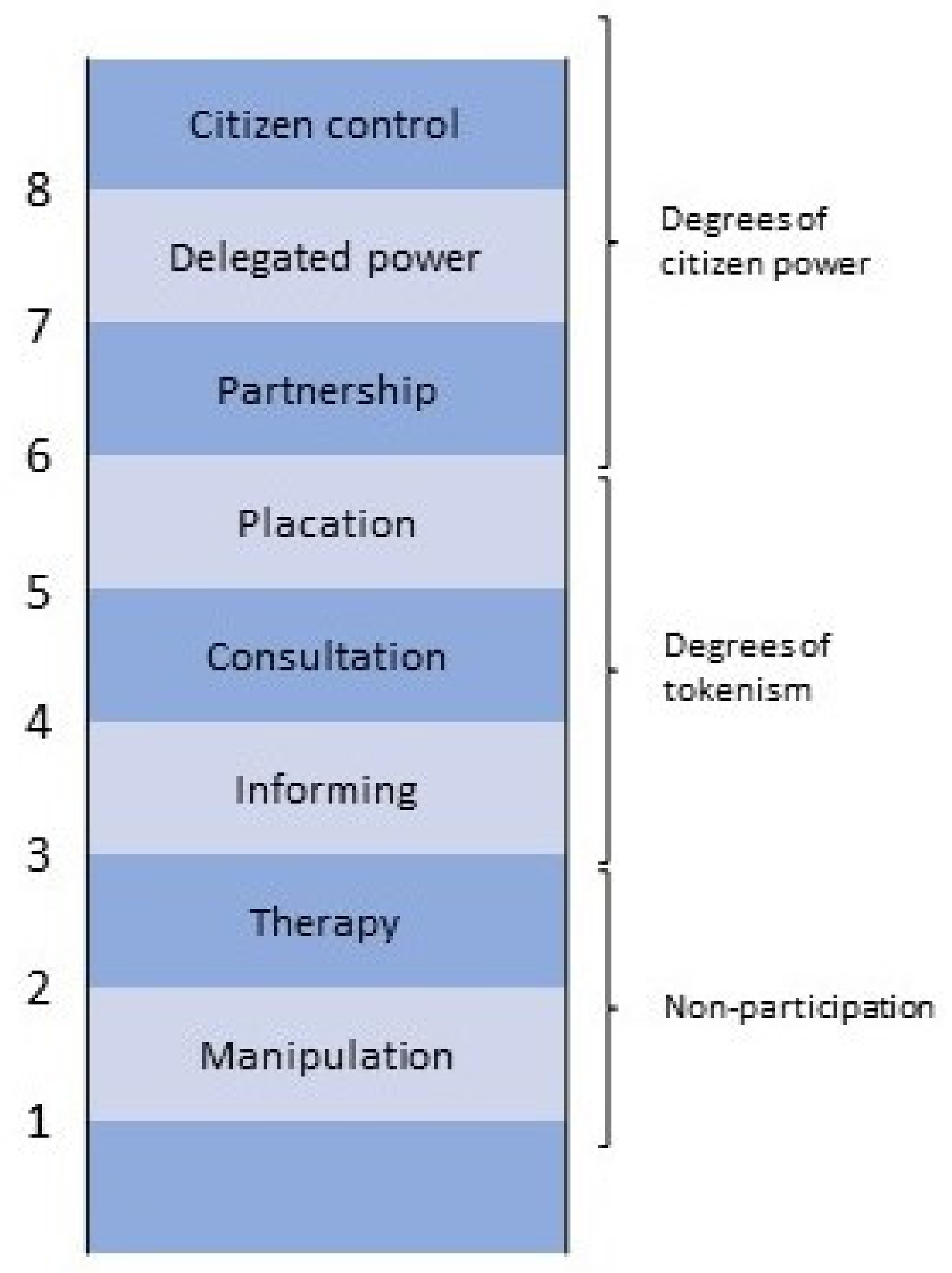
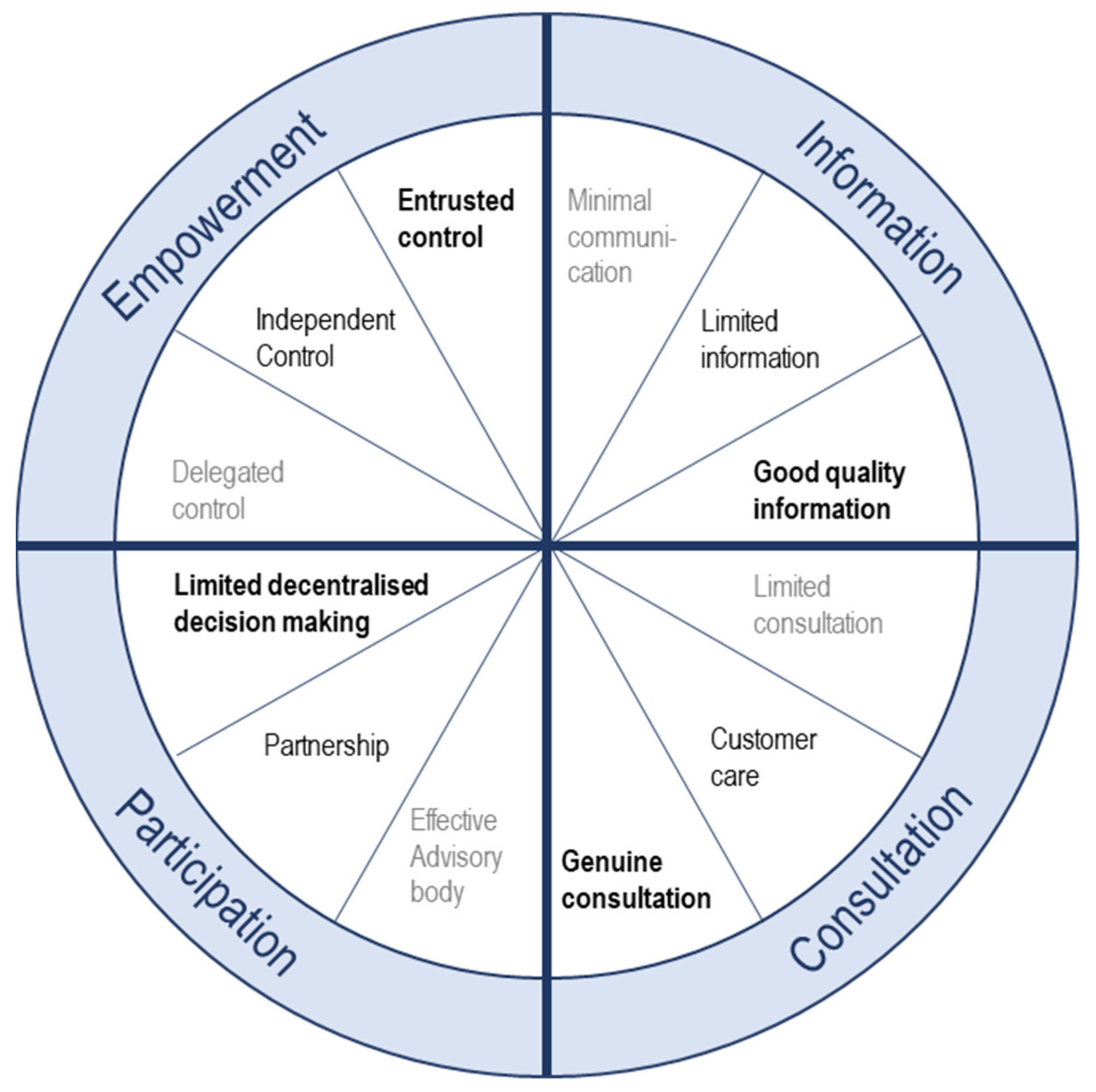


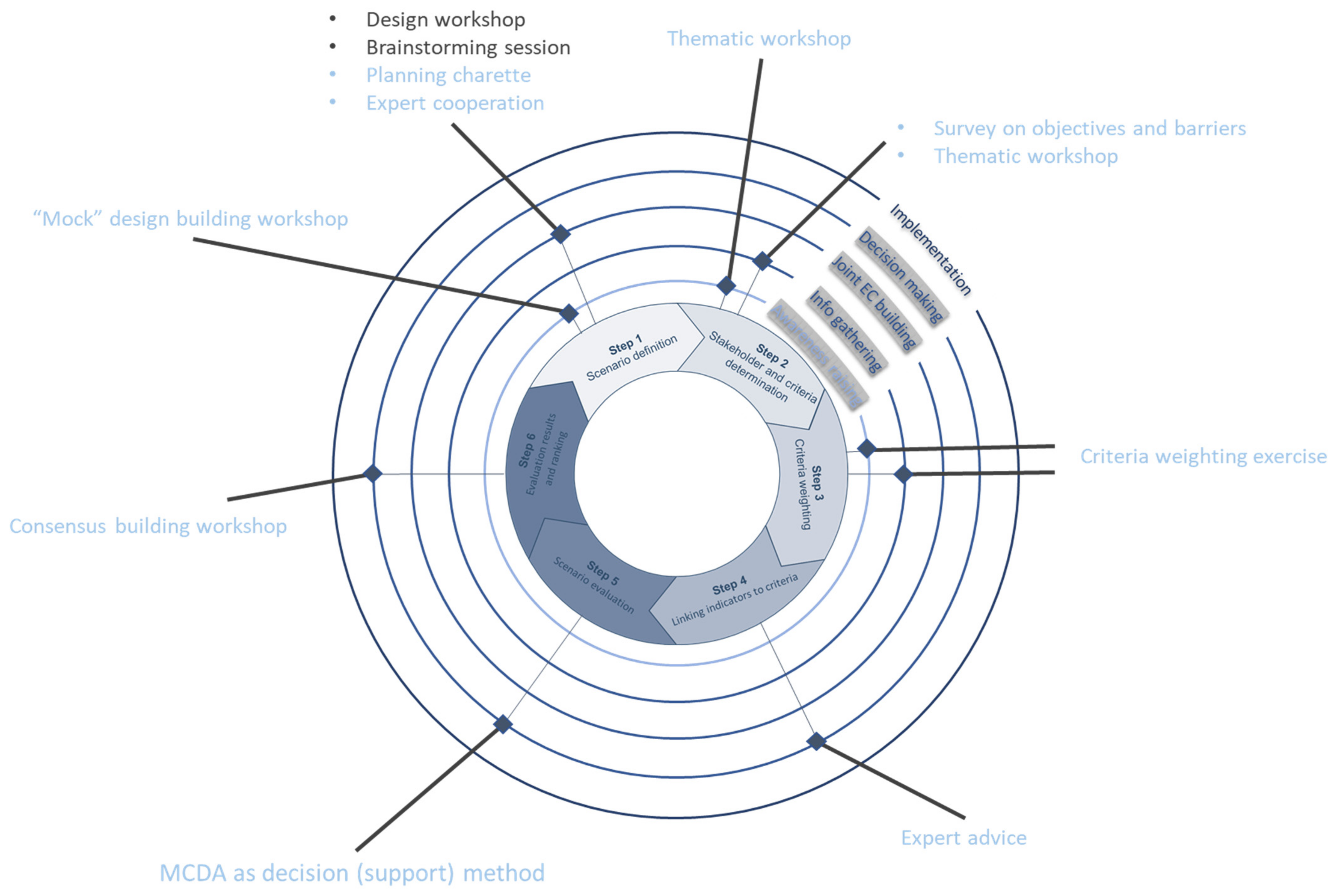

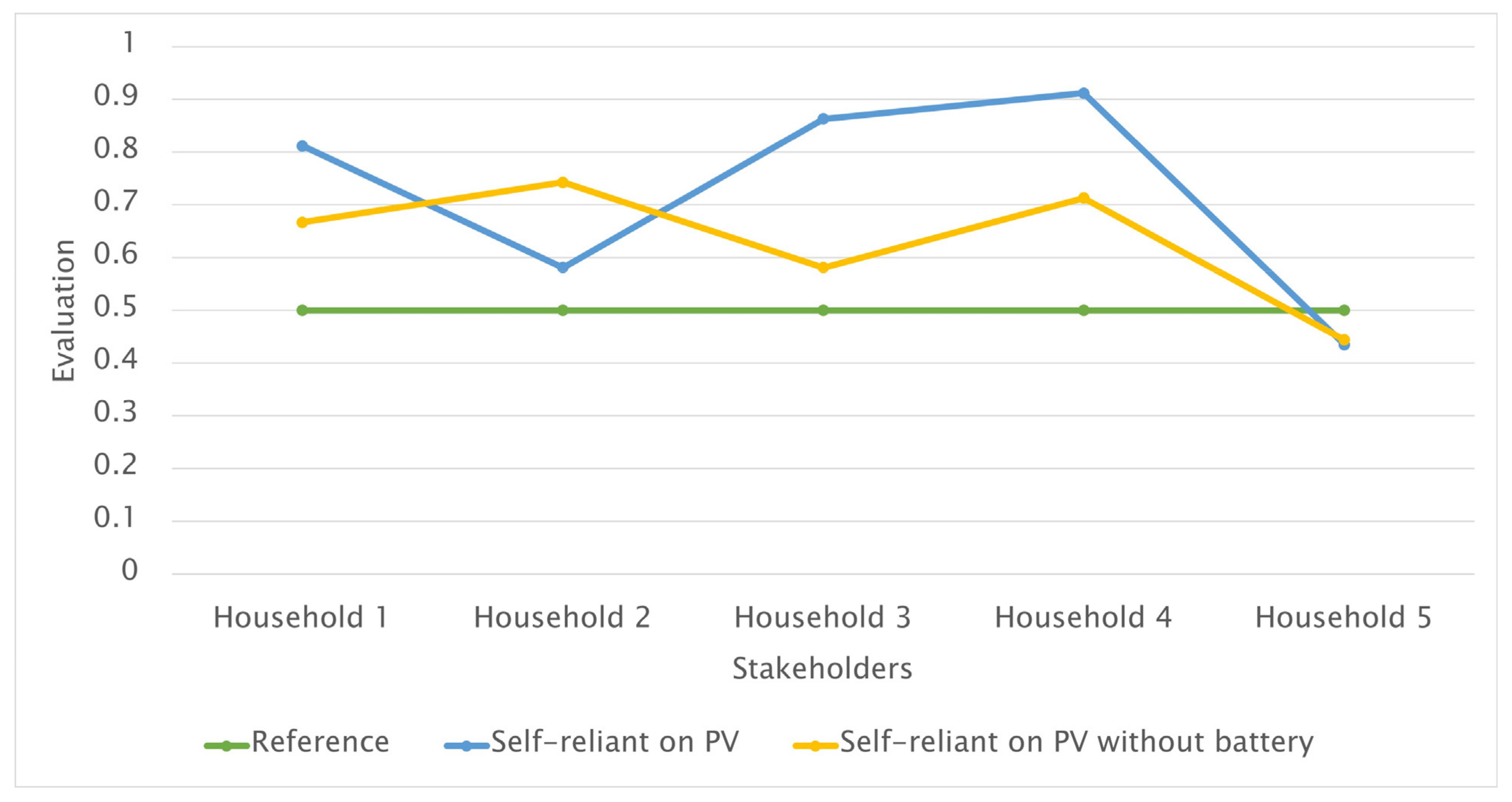
| MAMCA Framework Step | Engagement Goal | Engagement Tool | Additional Explanation of the Engagement Tool |
|---|---|---|---|
| Preparation | Awareness raising | Specific information session with Q&A | Potential stakeholders are invited to attend an interactive information session in which the workings of an EC in general are explained, as well as the potential benefits and barriers for their specific case. |
| Involving local project representatives | Local interested stakeholders assist in contacting and informing other potential stakeholders. | ||
| Information gathering for EC design input | Personal or public consultative meeting | When the stakeholders have no prior knowledge of ECs, information is provided and concerns are captured through a consultative meeting. This can be part of the information session. | |
| Step 1 (scenario definition) | Joint alternative EC design building | Design workshop | A design workshop can take on many forms, with different types of input from the stakeholders. |
| Brainstorming session | An expert translates the input from the stakeholders on their objectives and concerns into design alternatives that can be jointly discussed. | ||
| Planning charrette | Stakeholders build the alternative EC designs themselves, assisted by an expert, and take joint ownership of the developed solutions. | ||
| Expert cooperation | Assistance from experts in the field should always be part of this engagement stage seeing the technical components of ECs. | ||
| Awareness raising | “Mock” design building workshop | Workshop participants design their own EC, aided by experts and practical information tools, so they learn by doing about the different aspects of an EC and the questions that have to be answered. | |
| Step 2 (stakeholder and criteria determination) | Information gathering for EC design input | Survey on objectives and perceived barriers | A list of potential objectives is provided out of which the most relevant can be selected and added by the stakeholders. |
| Thematic workshop | During the workshop, stakeholders can present and mutually discuss in detail what they want to get out of an EC and which doubts they have. The objectives selection is also discussed. | ||
| Step 3 (criteria weighting) | Awareness raising | Thematic workshop | During the workshop the stakeholders explain their criteria to each other, to create mutual insight into potentially differing viewpoints. |
| Information gathering for EC design input | Exercise with weighting of stakeholder objectives (criteria) | Each stakeholder attributes a weight to its selected objectives according to the importance. | |
| Step 4 (linking indicators to criteria) | Awareness raising | Exercise with weighting of stakeholder objectives (criteria) | After the exercise the results of each stakeholder are visualized and explained to each other. This creates mutual insight and potential understanding. |
| Co-decision making | Expert advice | Experts in the field determine indicators for the selected stakeholder objectives that allow for the evaluation of the EC alternatives. | |
| Step 5 (scenario evaluation) | Co-decision making | MCDA as decision (support) method | The evaluation of the EC alternatives is carried out by the stakeholders based on how the alternatives score on their selected objectives. Input on technical evaluation components is provided by experts. |
| Step 6 (evaluation results and ranking) | Co-decision making | Consensus building workshop | The EC alternatives ranking resulting from the MCDA forms the basis of a stakeholder discussion that leads to a possible adaptation of the alternatives and a (group) decision on the EC design that will be implemented. |
| Engagement Goal during the EC Process | Engagement form by Arnstein [42] | Engagement form by Davidson [45] | How Tools That Comply with the Defined Engagement Form Can Fulfill the Engagement Goal |
|---|---|---|---|
| Phase A—Awareness raising | |||
| Awareness and knowledge raising | Informing | Information | By providing information on the topic, knowledge and awareness are raised. |
| Consultation | Consultation | Two-way information exchange enhances the feeling of involvement and sparks stakeholder interest. | |
| Phase B—EC design | |||
| Information gathering for design input | Consultation | Consultation | The gathered input is used for the EC design and decision making. |
| Joint alternative EC design building | Placation | Participation | The designed EC alternatives form the basis for the decision making. |
| Decision making | Partnership | Empowerment | Consensus building here is between all stakeholders (and technical experts) instead of between power holders and citizens. The end decision is made by the project initiator based on the results of the consensus-building process. |
| Delegated power | Empowerment | The end decision is the result of the consensus-building process. | |
| Phase C—Implementation | |||
| Implementation and continued active involvement | Citizen control | Empowerment | Initiatives are directed towards strengthening the community feeling and active involvement of the stakeholders, so the EC keeps running. |
| MAMCA Framework Step | Engagement Tool | Specific Application of the Tool | Tool Application Observations |
|---|---|---|---|
| Preparation | Specific information session with Q&A | A 20 min presentation was given with general information on all EC aspects, as well as potential pros and cons for Relleu. | Many questions were raised and answered throughout the presentation. |
| Involving local project representatives | The chairman of the Homeowners’ Association and a local resident personally contacted the other residents to explain the project and invite them to the engagement initiative. | All people who were contacted in this way agreed to attend the workshop. | |
| Step 1 (scenario definition) | Planning charrette | An interactive exercise was set up in which the stakeholders were divided into two groups that each received an expert assistant and a toolbox with building blocks that can make up an EC. Each group had to answer various questions and use the toolbox blocks to create alternative ECs. | The further into the exercise, the smoother it went. Conflicting views within the group were always discussed until a consensus was reached. |
| Expert advice | An expert assisted each stakeholder group in answering their questions and guiding them through each step of the alternatives design building. | The expert was able to not only assist and answer questions but also to raise additional questions and make the participants contemplate more on certain important issues. | |
| “Mock” EC design building workshop | The process for the ‘EC design and decision-making’ phase as a whole, assisted by experts answering all stakeholder questions, helps to build knowledge and awareness. | Participants indicated they understood the complexities of ECs and the steps that need to be taken in an EC setup process much better after the design workshop. | |
| Step 2 (stakeholder and criteria determination) | Survey on objectives and perceived barriers | The stakeholders filled out a survey in which they indicated their most important objectives when joining an EC, as well as the obstacles they see. | Participants indicated they selected multiple elements they had not thought of themselves before the survey, even though they thought they had a clear view beforehand. |
| Thematic workshop | Following the survey, the results were discussed in a group session in which each stakeholder was asked to elaborate more on their answers. | They could give more nuance to their survey answers, stress their most important issues, and even made adaptations after hearing each other’s points of view. | |
| Step 3 (criteria weighting) | Exercise with weighting of stakeholder objectives | The online MAMCA software tool, with the pairwise comparison feature, was used in an exercise in which all stakeholders gave weights to their selected objectives, according to importance. | The weighting results often were quite outspoken and put a specific focus on elements that might have otherwise been easily overlooked. The software was an important help to the participants, as were the resulting visuals for clarification. |
| Step 4 (linking indicators to criteria) | Expert advice | Before the workshop, for each of the objectives in the survey list, a panel of experts defined corresponding quantifiable criteria that can be used in the evaluation. | It was deemed necessary by the participants that this step be carried out by experts since they felt their knowledge of this complex and technical topic was insufficient to take on this step themselves. |
| Step 5 (scenario evaluation) | MCDA as decision (support) method | All stakeholders evaluated the EC alternatives based on their selected objectives, using the online MAMCA software supported by the AHP. Experts assisted with the scoring of the more complex topics. The resulting individual and joint preference ranking of the EC alternatives was then visualized. | The MAMCA software helped to better structure the evaluation process and was deemed very useful by the participants to ‘translate’ and input their evaluation views in a clear way. The expert assistance turned out to be necessary for the more technical parts of the assessment. |
| Step 6 (evaluation results and ranking) | Consensus building workshop | A consensus-building discussion was started with the stakeholders in which the evaluation results were compared and analyzed in detail, and an EC alternative that can be supported by all stakeholders was determined. | A consensus on a preferred EC form that was to be implemented was derived from the discussion. The MAMCA software visuals were an important help in structuring the discussion and pointing out conflicting opinions. |
Disclaimer/Publisher’s Note: The statements, opinions and data contained in all publications are solely those of the individual author(s) and contributor(s) and not of MDPI and/or the editor(s). MDPI and/or the editor(s) disclaim responsibility for any injury to people or property resulting from any ideas, methods, instructions or products referred to in the content. |
© 2023 by the authors. Licensee MDPI, Basel, Switzerland. This article is an open access article distributed under the terms and conditions of the Creative Commons Attribution (CC BY) license (https://creativecommons.org/licenses/by/4.0/).
Share and Cite
Heuninckx, S.; Macharis, C.; te Boveldt, G.; Coosemans, T. Evaluating the Potential of MAMCA as a Framework for Stakeholder Engagement during the Setup of Energy Communities. Energies 2023, 16, 3978. https://doi.org/10.3390/en16103978
Heuninckx S, Macharis C, te Boveldt G, Coosemans T. Evaluating the Potential of MAMCA as a Framework for Stakeholder Engagement during the Setup of Energy Communities. Energies. 2023; 16(10):3978. https://doi.org/10.3390/en16103978
Chicago/Turabian StyleHeuninckx, Shary, Cathy Macharis, Geert te Boveldt, and Thierry Coosemans. 2023. "Evaluating the Potential of MAMCA as a Framework for Stakeholder Engagement during the Setup of Energy Communities" Energies 16, no. 10: 3978. https://doi.org/10.3390/en16103978
APA StyleHeuninckx, S., Macharis, C., te Boveldt, G., & Coosemans, T. (2023). Evaluating the Potential of MAMCA as a Framework for Stakeholder Engagement during the Setup of Energy Communities. Energies, 16(10), 3978. https://doi.org/10.3390/en16103978





